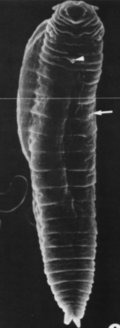Raillietiella teagueselfi
Raillietiella teagueselfi is a parasitic crustacean, that belongs to the phylum Arthropoda. They are found in tropical and sub-tropical regions and affects the lungs of reptiles. [1] It was named after Dr. John Teague Self, a zoologist from the University of Oklahoma, for his contributions on Pentastomida.
| Raillietiella teagueselfi | |
|---|---|
| Scientific classification | |
| Kingdom: | |
| Phylum: | |
| Class: | Ichthyostraca |
| Subclass: | |
| Order: | Raillietiellida |
| Family: | Raillietiellidae |
| Genus: | Raillietiella |
| Species: | R. teagueselfi |
Background information
Subclass Pentastomida
There are two major groups in the subclass Pentastomida: the Cephalobaenida and Porocephalida. The genus Raillietiella belongs to the group Cephalobaenida, which is more primitive than Porocephalida.[2] Pentastomids have an indirect life cycle and usually have hosts that are vertebrates. Species under this subclass generally have reptiles as their definitive host. The adult stage of pentastomids are found in the lungs. Once the eggs of the parasite are in the lungs, then they are coughed up, then swallowed back into the host and end in their feces. [3]
Development of genus Raillietiella sp.
Once the eggs are fertilized, the formation of an embryo or embryogenesis lasts about 3-4 weeks. Afterwards, the fully developed larva waits for an intermediate host. Then after 4 weeks, it enters the intermediate host. After being in the host for 6-8 weeks, the larvae is now infectious and goes into the definitive host and stays there for 8-10 weeks, which then become adults. After approximately 14-18 weeks, the larvae reaches sexual maturity.[4]
Discovery

On 1987, in Texas, James R. Dixon had noticed that the population of Hemidactylus turcicus, a Mediterranean gecko, had been increasing quickly all over Houston, Texas. A parasitologist, named John Riley and his team from the University of Dundee, Scotland, had experimented on H. turcicus and found an abundance of a unknown species of pentastomids in the lungs.[5]
Experiment
From 1986 to mid-1987, they collected a total of 86 geckos from various ages and were obtained from three different locations: Houston Zoological Gardens, St. Anne's Catholic Church (Houston), and in a private residence in Louisiana. The geckos were then killed with an overdose of sodium pentobarbital and inspected for any type of parasites.
Results
The only location that resulted with geckos infested with R. teagueselfi, were from the Houston Zoological Gardens. The parasites were found in their lungs and only in adults had the parasite. They did not find any correlation with the sex of the parasite, 28.1% of them were males and 32.0% of them were females.
Transmission
Due to the intensity of infection, in this species, they seem to think that this parasite adapted to an insect intermediate host, but since they only found the parasite in this one specific site, they are still unsure on the transmission of it and its factors.
Morphology

Females have a genital pore on their anterior ends, as well as pointed hooks. They also have hooks on their posterior ends but they are larger and have rounded tips instead of pointed tips. During the dissection, they examined some eggs within the female, and contained larvae with hooks that were fully developed.
Mature males have hooks with blunt tips on their posterior ends. Its body is wider on the upper half of its body and has an annulated abdomen. They also contain hooked copulatory spicules that aid in mating.
References
- Bosch, H. Z. Parasitenkd. (1986) 72: 673. https://doi.org/10.1007/BF00925489
- Esslinger, J. H. “Morphology of the Egg and Larva of Raillietiella Furcocerca (Pentastomida) from a Colombian Snake (Clelia Clelia).” The Journal of Parasitology, vol. 54, no. 2, 1968, pp. 411–416. JSTOR, www.jstor.org/stable/3276962.
- Divers, Stephen J., and Scott J. Stahl. Mader's Reptile and Amphibian Medicine and Surgery. Elsevier, 2019, pp.281-300.
- Thomas, Gabriele, Stender-Seidel, Susanne, and Böckeler, W. "Considerations about the Ontogenesis of Reighardia Sternae in Comparison with Raillietiella Sp. (Pentastomida: Cephalobaenida)." Parasitology Research 85.4 (1999): 280-83. Web.
- Riley, John, et al. “Raillietiella Teagueselfi n. Sp. (Pentastomida: Cephalobaenida) from the Mediterranean Gecko, Hemidactylus Turcicus (Sauria: Gekkonidae), in Texas.” The Journal of Parasitology, vol. 74, no. 3, 1988, pp. 481–486. https://www.jstor.org/stable/3282059?casa_token=iCobS2qtq
- Taxabox data taken from http://www.marinespecies.org/aphia.php?p=taxdetails&id=730238#links